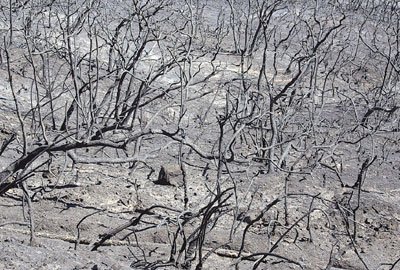GILROY
– When it comes to the aftermath of the Croy Fire, rainfall
means good news and bad news.
GILROY – When it comes to the aftermath of the Croy Fire, rainfall means good news and bad news.
The rains that eventually come this fall and winter could help firefighters finally snuff out “hot spots” left by the blaze once and for all, and also help prompt revegetation of hillsides within the 3,200-acre burn area that were damaged or laid bare by the flames.
But depending on the volume, that precipitation could also threaten to cause erosion and mudslides that can damage watersheds and important fish populations – as well as private property and drinking water.
To prevent as much of that damage as possible, the federal government and Santa Clara Valley Water District are cooperating to assess the threat of erosion and the kind of measures needed to combat it before the rainy season begins.
“Typically, the rainy season starts in November,” water district spokesman Mike DiMarco said Tuesday. “Our goal is to have something in the works by then. It all depends on how much rainfall there is and how it’s concentrated in the watersheds.
“What we’re trying to do is avoid the heavy, sustained rainfall that could lift up the (soil) hardpan and start the erosion process.”
The water district and U.S. Department of Agriculture’s Natural Resources Conservation Service sent out a team of specialists this week – including botanists, soil conservationists, engineers and geologists – to survey the fire area and analyze the damage.
“Our staff and NRCS went out yesterday and spent several hours walking the watershed, taking pictures and generally evaluating the conditions out there after the fire,” DiMarco said. “They’ll take all that information and formulate it into an action plan to try to stabilize the area before the rains hit in earnest.”
Uvas watershed hit
So far, the biggest concerns are centered around the Uvas Creek and Little Uvas Creek watersheds, portions of which run directly through Croy Road area where the fire began, DiMarco said. The fire burned up to and over the creek in some places in that area, causing significant damage.
“It’s very unstable up there, and we have the potential for mudslides or landslides under the wrong conditions,” DiMarco said.
Eastman Canyon, which lies to the south of Croy Canyon, also saw some extensive burning and could be impacted without human prevention measures, DiMarco said. Llagas Creek to the north and the Little Arthur and Bodfish Creek watersheds to the south appear to be relatively unscathed, he said.
The biggest concern is protecting private property in the aftermath of the fire, DiMarco said. The district also wants to keep sediment out of the creeks and eventually Uvas Reservoir, one of several reservoirs around the county where stored water is used to help recharge the groundwater basin that provides many Santa Clara Valley residents with drinking water.
“If that material washes into the reservoir, it can impede the ability of water to percolate into the basin,” DiMarco said. “It displaces room in there we’d rather see used for water, and it can be quite costly to try to clean it out.”
Preliminary estimates call for $400,000 in expenditures to stabilize after the fire. Up to $150,000 would come from the water district, with the federal government picking up the rest of the tab.
Measures could range from reseeding to laying out straw mats that stabilize the soil and catch native seeds, allowing them to germinate. Special temporary structures may also be built to catch debris coming down the hill and channel it away from waterways.
Once officials have fully analyzed the damage and drawn up an action plan – which could be released within the next several days – they’ll know more about what measures to take, he said.
“If private property owners can do things to assist, we’ll let them know,” DiMarco said.
For wildlife, the biggest impacts from the fire will probably be on the watersheds, fisheries and water quality from siltation, according to wildlife officials.
If the area experiences heavy November and December rains like last year, there will be major erosion and siltation damage, according to Keith Anderson, a retired state fisheries biologist who now represents the watershed advocacy group South Valley Streams For Tomorrow.
A heavy inflow of ash and silt into Uvas Reservoir could cause a major water quality problem for reservoir fish and other aquatic life, Anderson said – including possible fish kills. Quality of water released from the reservoir could also be degraded, he said, potentially causing more problems for steelhead trout.
Particularly worrisome, Anderson said, is that portions of Uvas Creek support a population of resident rainbow trout that are actually genetically landlocked steelhead trout. Steelhead are a threatened species that’s protected by the federal Endangered Species Act.
“Preserving this genetic source is very important for future attempts to recover and restore the steelhead population of the Uvas Creek watershed, and perhaps the Pajaro River basin …” Anderson said. “Adverse effects from the fire could harm the best steelhead population in the Pajaro River basin, and also set back steelhead recovery in the basin.”
Animals face hard winter
While more terrestrial animals and wildlife may have been able to escape the flames themselves, they may end up suffering through a hard winter because of the fire.
While the blaze burned, small mammals and reptiles that make their homes in the undergrowth were likely able to make their way to safety from the flames or burrow under and wait until it was safe to come out, said Santa Clara County Fish and Game Warden Henry Coletto.
“Except in places where the fire burned extremely hot and fast, the small animal population, the bird population should have fended for themselves just fine,” he said. “There are gopher and squirrel holes all over that country for them to get into … We don’t give the animals enough credit sometimes, but if they see or smell or hear the fire coming in their direction, they get out.”
Sue Howell, manager of the Wildlife Education and Research Center (WERC) said the center had not received any animals injured by the fire.
“It’s very unfortunate, but either they’re beyond help or they were able to get out altogether,” she said.
However, the animals that escaped the flames and burn area will now have to move to and survive in populated habitat areas that are already occupied by other species, Howell said Wednesday.
“Now comes the fight for survival,” she said.
The signs are already there. Howell said she’s has noticed an increase in the vulture population in some areas that’s probably a result of the birds moving in from their own lost habitat.
And WERC is receiving calls from people in surrounding areas who’ve noticed that opossums, raccoons and skunks they haven’t noticed before coming after their pets’ food dishes. Residents should choose to feed the pets during the day, she said.
And for many species, the movement into new territory comes at a time of year where there’s often a relative shortage of food in those areas as compared to other seasons, and the land’s ability to sustain a certain population of animals is already harder to maintain.
“At this time of year, it’s harder to survive,” Howell said.
But there may be an upside, Coletto said: The fire may actually help rejuvenate some feeding areas.
“New sprouts will quickly shoot up, especially if we have more heavy fogs than heavy winter rains … and the nutrition value of the vegetation will improve,” he said. “The ash itself is full of nutrients, which will enrich the soil and the plants that grow from it.”
Domestic animals also affected
Smoke from the fire caused respiratory problems for some domestic animals earlier this month, said San Martin veterinarian Pete Keesling – but not as many as he expected.
“Particularly the older animals, they are affected by poor air quality just as much as humans are,” Keesling said.
Respiratory distress may be just one of the problems domesticated animals in the area face. In the Sept. 23 evacuation of the area, many families did not have the time to find pets before they had to leave.
County Animal Control Officer Phillip Jewitt said some domestic animals did indeed perish on the first day of the fire, when residents weren’t allowed to return to their homes. But his office has received few calls since from residents looking for lost pets.
“Through the majority of the fire the fire department gave so much warning – because it was such a slow fire – that (residents) were able to get their animals out,” he said.
Neighbors were very supportive of pet and animal evacuation efforts, and there were also several volunteers, Jewitt said. The office is compiling a list of volunteers to submit to emergency officials for future incidents.
Staff Writer Marilyn Dubil contributed to this report.















